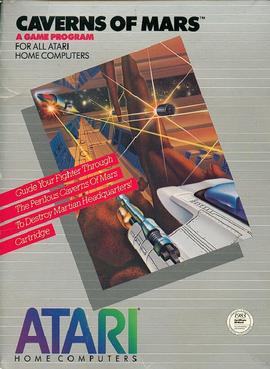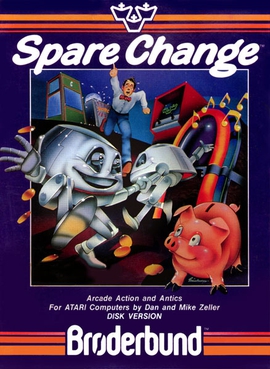Related Research Articles

The Atari 8-bit computers, formally launched as the Atari Home Computer System, are a series of 8-bit home computers introduced by Atari, Inc. in 1979 with the Atari 400 and Atari 800. It is the first home computer architecture with coprocessors, enabling more advanced graphics and sound than most of its contemporaries. Video games are key to its software library, and the 1980 first-person space combat simulator Star Raiders is considered the platform's killer app.

Choplifter is a military themed scrolling shooter developed by Dan Gorlin for the Apple II and published by Broderbund in 1982. It was ported to Atari 8-bit computers the same year and also to the VIC-20, Commodore 64, Atari 5200, ColecoVision, MSX, and Thomson computers.

B.C.'s Quest for Tires is an horizontally scrolling video game designed by Rick Banks and Michael Bate and published by Sierra On-Line in 1983. Versions were released for the Commodore 64, IBM PC, Atari 8-bit computers, ColecoVision, ZX Spectrum, MSX, and Apple II. Based on the comic strip B.C. by Johnny Hart, BC's Quest for Tires is similar to Irem's Moon Patrol from the previous year. A wheel-riding caveman is always moving forward through horizontally scrolling levels, and the player jumps or ducks as obstacles approach. The game's title is a play on the contemporaneous film Quest for Fire.

Shamus is a shooter with light action-adventure game elements written by Cathryn Mataga and published by Synapse Software. The original Atari 8-bit computer version was released on disk and tape in 1982. According to Synapse co-founder Ihor Wolosenko, Shamus made the company famous by giving it a reputation for quality. "Funeral March of a Marionette", the theme song from Alfred Hitchcock Presents, plays on the title screen.

Caverns of Mars is a vertically scrolling shooter for Atari 8-bit computers. It was written by Greg Christensen, with some features later added by Richard Watts, and published by the Atari Program Exchange (APX) in 1981. Caverns of Mars became the best selling APX software of all-time and was moved into Atari, Inc.'s official product line, first on diskette, then on cartridge.

Drol is a video game published by Broderbund in 1983. It was written for the Apple II by Benny Aik Beng Ngo, then ported to the Commodore 64 and Atari 8-bit computers. Versions were released for the SG-1000 in 1985 and Amiga in 1991.
Interactive Picture Systems, or IPS, was a software developer located in Philadelphia from 1982 to 1985. The company was run by partners Guy Nouri of NYC and Eric Podietz of Philadelphia. Staff included Jimmy Snyder, Mark Scott, Ken Appleman, Bob Svihovec, and Chip Kaye. IPS developed educational and creativity software initially for the Atari 8-bit computers, then for the Apple II, and Commodore 64. Movie Maker (1984) allows users to build elaborate animated sequences for the Atari 8-bit computers which can then be distributed as standalone files. It was initially released by Reston Publishing, then later by Electronic Arts along with Commodore 64 port.

Worms? is a puzzle video game written by David Maynard for Atari 8-bit computers and ported to the Commodore 64. It was released in 1983 as one of the first publications from Electronic Arts. Worms? is an interactive version of Paterson's Worms.

Many games, utilities, and educational programs were available for Atari 8-bit computers. Atari, Inc. was primarily the publisher following the launch of the Atari 400/800 in 1979, then increasingly by third parties. Atari also distributed "user written" software through the Atari Program Exchange from 1981 to 1984. After APX folded, many titles were picked up by Antic Software.

Transylvania is an adventure video game published by Penguin Software. It was released for the Apple II in 1982 followed by ports to the Atari 8-bit computers and Commodore 64. A Mac conversion was published in 1984, then versions for the Amiga, Atari ST, and MS-DOS in 1985.

Wayout is a 3D first-person perspective video game programmed by Paul Allen Edelstein and published for the Atari 8-bit computers in 1982. It was released for the Apple II and Commodore 64 in 1983. Wayout is among the first maze games to offer full 360 degree 3D perspective and movement, and its graphics were considered state-of-the-art upon its release. There were many pseudo-3D maze games at the time, but they used a fixed perspective and limited the player to four orientations.

Preppie! is an action video game for Atari 8-bit computers published by Adventure International in 1982. It was programmed by Russ Wetmore of Star Systems Software, whose name is prominently displayed on the box cover. Leaning on the preppy trend of the early 1980s, the game follows prep schooler Wadsworth Overcash as he navigates the hazards of a country club to retrieve golf balls. Preppie! borrows heavily from Konami's Frogger, with lanes of traffic in the bottom half of the screen and a river crossing the top portion. Alligators are an element from both Frogger and preppy fashion; an open-mouthed gator is the icon of shirt brand Izod. Reviewers recognized the game as derivative, but called the music and visuals some of the best for Atari 8-bit computers.

Drelbs is a maze video game written by Kelly Jones for Atari 8-bit computers and published by Synapse Software in 1983. An Apple II port by Jonathan Tifft was released the same year. A Commodore 64 version followed in 1984 implemented by Miriam Nathan and William Mandel. The objective is to move the walls of the maze to make boxes. Some reviewers found the overall collection of elements to be eccentric and unique.

Wavy Navy is a video game designed by Rodney McAuley for the Apple II and published by Sirius Software in 1983. Versions for the Atari 8-bit computers and Commodore 64 were released the same year. Wavy Navy is a nautically themed fixed shooter with left and right controls to move the player's PT boat, but there is an additional vertical element as the boat moves up and down with the large ocean waves that scroll beneath it. The direction and speed of the waves vary per level. Some reviewers found that the movement of the waves added an interesting twist, while others called it too similar to other fixed shooters like Galaxian.

Floyd of the Jungle is a 1982 platform game for Atari 8-bit computers and part of the initial batch of games from MicroProse. Designed and programmed by company co-founder Sid Meier, it is one of the few 2D action games he created and the only platform game. It allows up to four players at once.

Hockey is a ice hockey video game published by Gamma Software for Atari 8-bit computers in 1981. Gamma released the Atari 8-bit game Soccer the following year.

Starbowl Football is an American football video game published in 1982 by Gamestar for Atari 8-bit computers. An earlier version of the game was sold by Arcade Plus as Arcade Pro Football.

Spare Change is an action game designed by Dan and Mike Zeller and published in 1983 by Broderbund for the Apple II and Atari 8-bit computers. A Commodore 64 version was written by Steven Ohmert and released the same year. Ports for FM-7 and Sharp X1 were released in 1985. The difficulty of Spare Change can be customized through seven settings at the "Zerks Control Panel".

Kid Grid is a grid capture game which borrows heavily from the 1981 arcade video game Amidar. Written by Arti Haroutunian for Atari 8-bit computers, it was published by Tronix in 1982. A Commodore 64 port from the same programmer was released in 1983. In Kid Grid, the player moves along the horizontal and vertical lines of the playfield, turning the lines from dotted gray to solid blue. If all the lines around a square are completed, it is filled-in. Deadly creatures chase the player.

Threshold is a space-themed fixed shooter written by Warren Schwader and Ken Williams for the Apple II and published by On-Line Systems in 1981. Inspired by Sega's Astro Blaster arcade video game, Threshold introduces many enemy ship types and wave formations as the game progresses. Reviewers found the variety distinguished the game from the many similar shoot 'em ups.
References
- 1 2 Stone, David P. (June 1984). "Micro-Reviews". Computer Gaming World. Vol. 1, no. 16. pp. 30–33.
- ↑ Wickman, Peter (April 1984). "Product Reviews: Movie Maker". Antic. 3 (1).
- ↑ Williams, Gregg (May 1986). "Atari Playfield". Computer Gaming World. Vol. 1, no. 28. p. 28.